With all the buzz surrounding cars like the Mitsubishi i-MiEV, the Nissan Leaf and Tesla Roadster, not to mention hybrid petrol-electrics like the Toyota Prius and Honda Civic Hybrid, you’d think that electricity-powered cars were a relatively recent innovation. But you’d be wrong. They may be touted as the future of personal transport, but electric cars are not new to North America, Europe or even Australia.
I write short articles as well as long feature “explainer” articles on topics including: Google Android Smartphones and Tablets, National Broadband Network (NBN), Space, Civil & Military Aviation, Ebooks and the Publishing Industry, Electric cars, Technology augmenting human capabilities etc for Geare Magazine. The editor of GEARE has kindly permitted me to post articles here after the magazine issue the article was printed in has passed its shelf life.
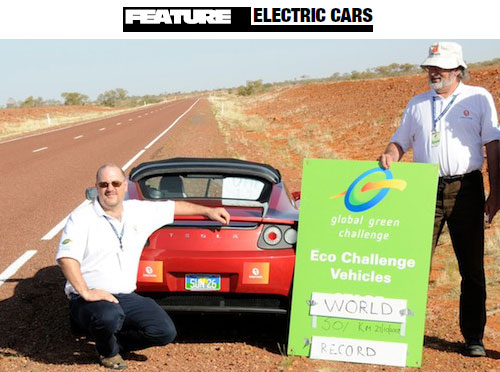
In The Beginning
Electric cars were present at the very dawn of the automobile age. In the late 1800s they were competing against petrol and steampowered vehicles (yes, steam!) to become the dominant motoring energy source. And they were being used not just for transporting people through the streets and alarming the more sedate horse-drawn carriages.
Electric vehicles included surprisingly aerodynamic designs capable of speeds that were unheard of in a personal vehicle. Indeed in the early 1900s it seemed that electric cars had a strong chance of becoming the mainstream form of motor vehicle for the new century. After all, even the Queen herself was driving one…
“If anything were wanting to invest the pastime of motoring with greater popularity in ladies’ eyes it is surely supplied by the fact that Queen Alexandra [EDITOR: wife of then British monarch Edward VII] has not only purchased for herself a Victoriette, but has learnt to drive it herself. Electricity is the motive force of the extremely smart little vehicle, with seats for two, that her Majesty has selected.”
– excerpt from The Sydney Morning Herald published 29th June 1901
Today we tend to view most electric vehicles as lacking in, well, ‘spark’, when it comes to speed. But the first half-dozen land-speed records were all set by electricity powered cars, including the first motor vehicle to break the 100km/h speed barrier.
In 1898 a record of 62.78km/hr (39.24mph) was set by Frenchman Gaston Chasseloup-Laubat in a Jeantaud electric car. Belgian driver Camille Jenatzy achieved several records before breaking the 100km/h barrier (a new record of 105.26 km/h, 65.79 mph) in his torpedo-shaped car named La Jamais Contente (‘The Never Satisfied’).
Although electric cars offered the benefits of less noise and no exhaust pollution during use, they lost out in the long run to the internal combustion engine. Petrol engines were cheaper to mass produce, and the fuel itself was relatively cheap (with massive companies like Standard Oil backing it).
SIDE NOTE: I read a very interesting book Internal Combustion: How Corporations and Governments Addicted the World to Oil and Derailed the Alternatives as part of background research into writing this article about Electric Cars.
Modern-day Electric Car Pioneers
Simon Hackett, the founder and MD of internet service provider Internode is one of Australia’s most prominent advocates for electric cars. He imported the world’s first modern fully-electric supercar, the Tesla Roadster, to Australia in early 2009.
Hackett and his co-driver Emilis Prelgauskas then broke the record for distance travelled on a single charge by a production electric vehicle in October 2009, when they drove Hackett’s factory-standard 2008 model Tesla Roadster 501km (313 miles) as part of the Global Green Challenge.
Hackett wrote about the experience, which took them through the Australian Outback from just south of Alice Springs to a distance marker on the highway 183km north of Coober Pedy in South Australia.
“The point of the exercise is to demonstrate that it is possible to be both green and high performance – like a Roadster, and indeed, like Internode… I strongly believe that electric vehicles are the future of motoring and this is the most concrete way that I can personally contribute to educating people in Australia about just how real they are. In the Tesla, people can see what the future of cars looks like.“
Lithium-Ion Batteries for Electric Cars
Electric cars are seen by some as a way to reduce dependence on foreign oil suppliers located in volatile areas like the Middle East, the ex-Soviet bloc and South America. But electric cars use lithium for their batteries, the soft, light metal also used for batteries in smartphones and laptops. There will be increasing demand for it in the future, and just like oil, relatively few countries control the supply. Bolivia featured in an ABC TV Foreign Correspondent show earlier this year because of internal tensions regarding whether the country should exploit vast lithium deposits in the Salar de Uyuni.
Lithium batteries can at least be reprocessed at the end of their useful life, which can’t be said for petrol, LPG and diesel. And there are good reserves of lithium in the USA, Canada, China, Australia, Chile and Argentina, as well as Bolivia.
Diesel and Hydrogen
I drove a diesel Ford Econetic for several weeks early in 2010. It had admirably low fuel consumption levels and certainly proved more cost effective to buy than a Toyota Prius. But it’s hardly a solution for personal transport. Diesel is a fossil fuel and its exhaust is classified by the US National Library of Medicine as a human carcinogen (which means it causes cancer)..
“Diesel engines are a major source of fine particles, and diesel exhaust releases particles at a rate about 20 times greater than that from petrol-fuelled vehicles” – Australian Greenhouse Office (PDF)
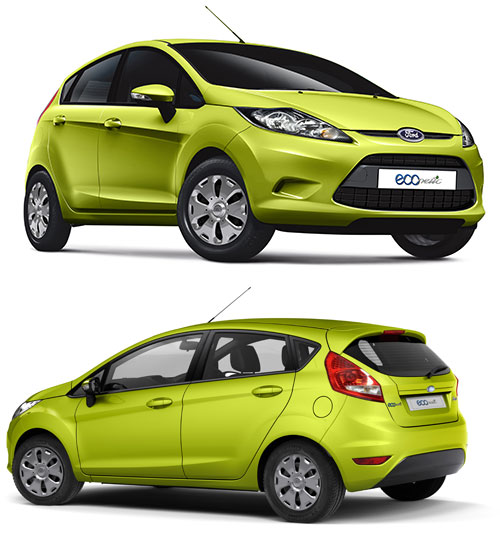
So at best diesel cars should be considered as a short-term stop-gap. There is also much noise around hydrogen as a power source for transportation. But there are several big issues with hydrogen as a fuel source for cars.
Switching to hydrogen would require building every part of the supply chain from scratch, from plants to create hydrogen in sufficient quantities, through ways to safely
transport a fuel that is combustible and easily ignited, up to refuelling stations around the country storing large amounts of hydrogen in tanks.
“In order to get significant deployment, you need four significant technological breakthroughs. That makes it unlikely” was the judgement of Steven Chu, the 1997 Nobel Prize Winner for Physics and the man who was chosen as Energy Secretary when US President Obama was elected. In an interview with Businessweek, Chu signalled his intent to cut funding into research on hydrogen as a fuel source for cars, saying “it always looked like it was going to be [a technology for] the distant future.”
Whereas for electricity, there’s already a well-established transport grid and generation network available around Australia (and overseas).
Furthermore a Scientific American examination of hydrogen feasibility points out that “right now 95% of the hydrogen available in the United States is either extracted from fossil fuels or made using electrolytic processes powered by fossil fuels, thus negating any real emissions savings or reduction in fossil fuel usage”.
So for now we’re down to two options – stick with petrol, or go electric.
Power sources
One of the anti-hydrogen arguments potentially applies to electricity, of course. Does using electricity for cars merely move CO2 and other toxic emissions away from cities to the coal-fired power stations that produce the electricity? Given that most of Australia’s electricity power generation relies on coal-fired power plants (such as the 2640MW Bayswater power station in NSW’s Hunter Valley and Victoria’s Loy Yang A & B power stations which together generate 3250MW of electricity), will we then concentrate roughly the same greenhouse emissions in regional and rural areas?
The answer, sadly, will be yes – if people who buy electric cars decide to charge their car at home, drawing electricity from the national grid. But there are other potential options, including battery swap-out, switching to an accredited Green Power electricity supplier, or generating charging power onsite using photovoltaic solar cells on the roof.
Better Place
One company highlighting the problems of charging from the grid is Better Place, a venture-backed company which plans to roll out electric car recharging and swift battery swap infrastructure (the equivalent of petrol stations) across Australia, Israel, China, USA, Japan and Denmark in the next few years.
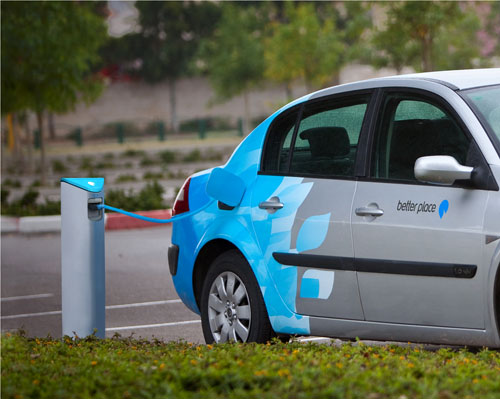
Better Place points out a major problem in home charging – an electric vehicle is likely to draw around 3kW of power when charging, around three times the consumption of a wall mounted air-con unit in a small apartment. And charging tends to happen as soon as the owner arrives home from work – right in the middle of evening peak demand. It wouldn’t take a very high percentage of electric car users before power providers would face peak-handling chaos.
Battery swap and recharging solutions would mitigate this, as well as solve the chicken-and-egg problem where people are reluctant to buy an electric car because they fear the battery will run out before they find a place to recharge.
Better Place also plans to address the costly upfront cost of electric car batteries by leasing them to customers and offering battery swaps at its recharge stations for compatible cars.
The company is not alone in its goals, however, and it’s likely that others (including car manufacturers besides Better Place’s partners Renault/Nissan) will try and sell or lease batteries to drivers directly, leading to a hodgepodge of different battery standards.
Still, the plans of Better Place Australia are advanced enough for it to sign long-term purchase agreements that will help power companies like AGL get the finance they need to build more wind, solar and other 100% renewable electricity.
The Australian part of the project will start with construction of recharge stations in Canberra during the second half of 2011, ready for use in early 2012. ACTEW AGL is ready to provide Better Place with renewable energy for their charging stations. A Better Place Australia spokesperson told Geare that the company has an ambitious plan to roll out recharge stations nationwide by the end of 2013.
EDITOR: I’ve previously written a detailed article about Better Place and it’s plans for Australia.
How Long Until Electric Cars are Commonplace?
Look around at traffic in major Australian cities right now and you’ll struggle to spot any electric cars at all. And no wonder – few people can afford the US$100,000+ price-tag of a Tesla Roadster, or justify the payback period for investing roughly $15,000 to convert an existing petrol car to electric battery power.
Small-scale trials of electric cars are currently being run by several state and local governments. Victoria is swapping a pool of 60 electric vehicles between households to assess them in real-life conditions. The City of Sydney is testing a Mitsubishi i-MiEV electric car, as well as several dozen hybrids.

How fast will the change take place? Carlos Ghosn, CEO and President of Renault and Nissan, predicts that roughly 10% of the world’s car fleet will run on battery power alone by 2020. If the shift happens any faster it will be thanks to risk takers like Better Place setting up the infrastructure, early adopters like Simon Hackett, and evangelists such as the UniSA team who drove a small custom-built Australian electric car (appropriately called ‘Trev’) around the world in 80 days as part of the 2010 Zero Race.
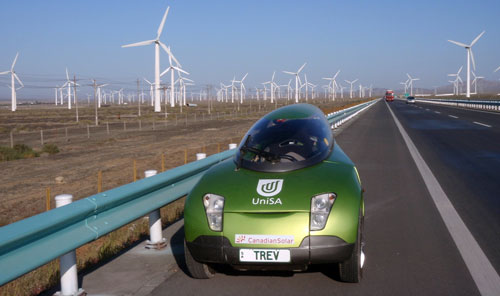
A Cautionary Tale
History has a lot to teach us about the future. Visitors to Sydney’s Powerhouse Museum storage warehouse in Castle Hill can see a 1917 Detroit Electric Car, one of several used by a Sydney solicitor and his family.
The museum curators explain that:
“during the First World War the cost of petrol doubled in Australia, and electric cars became so popular that in 1916, Sydney City Council set up a special charging station in Palmer Street, where owners could recharge their vehicles for a reasonable fee. At this time it was expected that the petrol engine would soon become obsolete.”
– Powerhouse Museum
Back then, of course, there were powerful vested interests in the form of oil companies, petrol station owners and manufacturers of internal combustion cars… Oh wait, there still are…
This article was originally published in GEARE Magazine issue #64. It is “digitally reprinted” here with permission from the editor.
The following video is a related topic: an excerpt from an ABC TV 4 Corners documentary about Peak Oil.


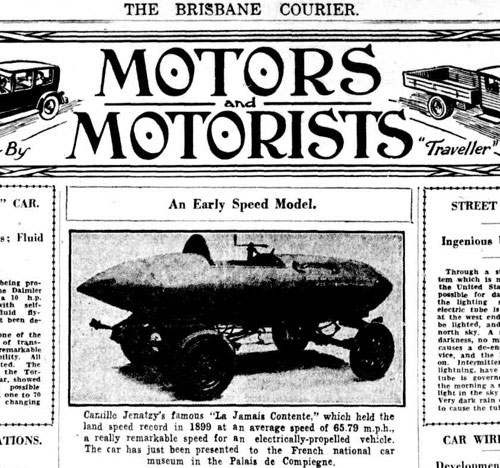
Leave a Reply